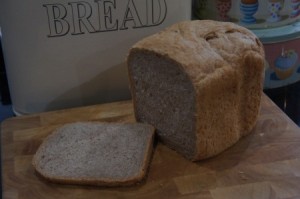Any ideas what the following list of ingredients is from?
Water, tapioca starch, potato starch, vegetable oil, wholegrain maize flour, egg white powder, yeast, cellulose gum, concentrated fruit juice, dextrose, rice bran, cornflour, sugar beet fibre.
Would you believe me if I told you it was the ingredients of a shop-bought gluten free loaf? And that isn’t the whole list either.
Ever since discovering that my son is intolerant to both wheat and dairy, I have had to resort to buying the gluten free, wheat free and dairy free bread that is available in the supermarket. But looking at the ingredients list horrified me and so I knew that the only option left was to make my own.
Well finally I bought a bread maker, which has a gluten free programme and was so excited when it arrived at the weekend (yes, it is amazing what I get excited about these days). In the meantime I have been doing some investigating, looking at different options and I have found an alternative to wheat that my son can tolerate (because he is not sensitive to gluten, he does not technically need to be gluten free, but the majority of wheat free options naturally are).
The grain is Spelt, an ancient grain, which was the staple of the poor until modern farming took over in the 20th century. Although classed as a member of the wheat family, spelt is a genetically different species, remaining unchanged by genetic modification, cross-breeding or any other form of hybridisation. Spelt fell out of favour to its cousin, wheat, due to the ease with which wheat could be mass produced. The tough outer husk of the spelt grains requires an extra step in the processing stage in order to remove it. This made it a more expensive and less viable option to grow.
Spelt is seeing a resurgence in popularity. Some people who are intolerant to modern wheat find that they can tolerate spelt. The higher level of protein in spelt, which is molecularly more brittle and water soluble than the protein in wheat, is possibly why it can be more easily digested. Unfortunately spelt is not a gluten free grain, so is not suitable for Coeliacs. But for my son it is a blessing that he is able to eat spelt, as it is a tasty alternative to wheat and one that we can all enjoy. The gluten in this grain allows it to be substituted for normal wheat flour in order to make a ‘normal’ loaf. And guess what? I made my first loaf in the new bread maker yesterday (and it didn’t require the gluten free option either). Here it is:
It looks pretty rustic, but it tastes good and better still, look at the ingredients list:
Spelt flour, yeast, sugar, butter (sunflower spread, in our case), water.
That’s more like it, isn’t it?


Well done for making home made bread! As well as spelt have you tried buckwheat? It has a slight nutty taste. I have used it to make lovely flat breads and even as a substitute for split pea flour in onion bhaji recipes!
Can you use it with yeast to make a risen loaf?
Probably- though I haven’t tried it myself. I think you can use it as an alternative to regular plain flour. Although its called buckwheat its actually not wheat based at all, i believe its a seed from a type of flower. I am going to try to make pancakes with the rest of my packet this weekend. Good luck! X
Thanks for that. I will look in to it.